Dry and Wet Deposition Fluxes and Source of Atmospheric Mercury in the Forest in Southeast China
Abstract
:1. Introduction
2. Materials and Methods
2.1. Sampling Site and Sample Collection
2.2. Laboratory and Statistical Analysis
2.3. Quality Assurance/Quality Control
2.4. Calculation for Deposition Flux
3. Results and Discussion
3.1. The Concentration and Seasonal Trends of Hg
3.2. The Deposition Fluxes and Variations Trends of Hg in Atmospheric
3.3. The Impact of Precipitation on Atmospheric Hg Deposition
3.4. The Source of Atmospheric Hg Deposition
4. Conclusions
Supplementary Materials
Author Contributions
Funding
Acknowledgments
Conflicts of Interest
References
- Schroeder, W.H.; Munthe, J. Atmospheric mercury—An overview. Atmos. Environ. 1998, 32, 809–822. [Google Scholar] [CrossRef]
- Obrist, D.; Kirk, J.L.; Zhang, L.; Lei, Z.; Sunderland, E.M.; Martin, J.; Selin, N.E. A review of global environmental mercury processes in response to human and natural perturbations: Changes of emissions, climate, and land use. AMBIO 2018, 47, 116–140. [Google Scholar] [CrossRef] [PubMed]
- Eric, K.M.; Alan, V.; Gerald, J.K.; Ann, C.; Laurier, P.; Neil, C.K.; Raynald, B. Estimation and Mapping of Wet and Dry Mercury Deposition Across Northeastern North America. Ecotoxicology 2005, 14, 53–70. [Google Scholar]
- Yu, X.; Driscoll, C.T.; Huang, J.; Holsen, T.M.; Blackwell, B.D. Modeling and mapping of atmospheric mercury deposition in Adirondack Park, New York. PLoS ONE 2013, 8, e59322. [Google Scholar] [CrossRef] [PubMed]
- Ma, M.; Du, H.; Wang, D.; Sun, T.; Sun, S.; Yang, G. The fate of mercury and its relationship with carbon, nitrogen and bacterial communities during litter decomposing in two subtropical forests. Appl. Geochem. 2017, 86, 26–35. [Google Scholar] [CrossRef]
- Corbitt, E.S.; Jacob, D.J.; Holmes, C.D.; Streets, D.G.; Sunderland, E.M. Global source–receptor relationships for mercury deposition under present-day and 2050 emissions scenarios. Environ. Sci. Technol. 2011, 45, 10477–10484. [Google Scholar] [CrossRef]
- Jiang, X.; Wang, F. Mercury emissions in China: A general review. Waste Dispo. Sustain. Energy 2019, 1, 127–132. [Google Scholar] [CrossRef]
- Wang, X.; Yuan, W.; Feng, X. Global Review of Mercury Biogeochemical Processes in Forest Ecosystems. Chem. Ind. Eng. Prog. 2017, 29, 970–980. (In Chinese) [Google Scholar]
- Keenan, R.J.; Reams, G.A.; Achard, F.; de Freitas, J.V.; Grainger, A.; Lindquist, E. Dynamics of global forest area: Results from the FAO Global Forest Resources Assessment. For. Ecol. Manag. 2015, 352, 9–20. [Google Scholar] [CrossRef]
- Wenfu, Z.; Xiaohai, W.; Huaze, Z.; Danni, A.; Rufeng, Z.; Qizhao, S.; Shengqiang, L.; Wei, Y. Spatial distribution of Mercury in Bubeng Typical Tropical Forest of Yunnan Province, China. Earth Environ. 2022, 50, 352–359. (In Chinese) [Google Scholar]
- Blackwell, B.D.; Driscoll, C.T.; Maxwell, J.A.; Holsen, T.M. Changing climate alters inputs and pathways of mercury deposition to forested ecosystems. Biogeochemistry 2014, 119, 215–228. [Google Scholar] [CrossRef]
- Blackwell, B.; Driscoll, C. Deposition of Mercury in Forests along a Montane Elevation Gradient. Environ. Sci. Technol. 2015, 49, 5363–5370. [Google Scholar] [CrossRef] [PubMed]
- Ma, M.; Wang, D.; Du, H.; Sun, T.; Zhao, Z.; Wei, S. Atmospheric mercury deposition and its contribution of the regional atmospheric transport to mercury pollution at a national forest nature reserve, southwest China. Environ. Sci. Pollut. Res. 2015, 22, 20007–20018. [Google Scholar] [CrossRef]
- Ma, M.; Wang, D.; Du, H.; Sun, T.; Zhao, Z.; Wang, Y.; Wei, S. Mercury dynamics and mass balance in a subtropical forest, southwestern China. Atmos. Chem. Phys. 2016, 16, 4529–4537. [Google Scholar] [CrossRef]
- Ma, M.; Lai, D.; Sun, T.; Yang, G.; Wang, D. Mercury dynamics and mass balance in a subtropical forest in southwest China. China Environ. Sci. 2017, 37, 4744–4750. (In Chinese) [Google Scholar]
- Ye, L.; Huang, M.; Zhong, B.; Wang, X.; Tu, Q.; Sun, H.; Wang, C.; Wu, L.; Chang, M. Wet and dry deposition fluxes of heavy metals in Pearl River Delta Region (China): Characteristics, ecological risk assessment, and source apportionment. J. Environ. Sci. 2018, 70, 106–123. [Google Scholar] [CrossRef]
- Liu, J.; Wang, W.; Peng, A. The Source of Mercury in Rainfall in Beijing. Environ. Sci. 2000, 2, 77–80. (In Chinese) [Google Scholar]
- Zhang, G.; Zheng, X.; Zhou, L.; Huang, W.; Qian, P.; Wang, Y. Assessment of atmospheric wet deposition mercury and ecological risks in Shanghai. Environ. Chem. 2010, 29, 147–148. (In Chinese) [Google Scholar]
- Guo, Y.; Feng, X.; He, T.; Zhang, J.; Liang, P.; Meng, B.; Yao, H. Temporal and spatial distribution of different mercury species in precipitation of Wujiang River Basin. J. Environ. Sci. 2008, 7, 1441–1446. (In Chinese) [Google Scholar]
- Ma, M. Mercury Inputs, Outputs, and Sources under the Forest Canopy in Typical Subtropical Forest Ecosystem of Southwest China; Southwest University: Chongqing, China, 2013. (In Chinese) [Google Scholar]
- Keeler, G.J.; Landis, M.S.; Norris, G.A.; Christianson, E.M.; Dvonch, J.T. Sources of Mercury Wet Deposition in Eastern Ohio, USA. Environ. Sci. Technol. 2006, 40, 5874–5881. [Google Scholar] [CrossRef]
- Shanley, J.B.; Engle, M.A.; Scholl, M.; Krabbenhoft, D.P.; Brunette, R.; Olson, M.; Conroy, M.E. High Mercury Wet Deposition at a “Clean Air” Site in Puerto Rico. Environ. Sci. Technol. 2015, 49, 12474–12482. [Google Scholar] [CrossRef]
- Eom, S.; Lee, H.; Kim, J.; Park, K.; Kim, Y.; Sheu, G.R.; Gay, D.A.; Schmeltz, D.; Han, S. Potential sources, scavenging processes, and source regions of mercury in the wet deposition of South Korea. Sci. Total Environ. 2021, 762, 143934. [Google Scholar] [CrossRef]
- Hansen, A.M.; Gay, D.A. Observations of mercury wet deposition in Mexico. Environ. Sci. Pollut. Res. 2013, 20, 8316–8325. [Google Scholar] [CrossRef]
- Eyrikh, S.; Shol, L.; Shinkaruk, E. Assessment of Mercury Concentrations and Fluxes Deposited from the Atmosphere on the Territory of the Yamal-Nenets Autonomous Area. Atmosphere 2021, 13, 37. [Google Scholar] [CrossRef]
- Chen, Q. Dry and Wet Deposition Fluxes and Source of Atmospheric Mercury in Xiamen; Xiamen University: Xiamen, China, 2016. (In Chinese) [Google Scholar]
- Enrico, M.; Roux, G.L.; Marusczak, N.; Heimbürger, L.E.; Claustres, A.; Fu, X.; Sun, R.; Sonke, J.E. Atmospheric Mercury Transfer to Peat Bogs Dominated by Gaseous Elemental Mercury Dry Deposition. Environ. Sci. Technol. 2016, 50, 2405–2412. [Google Scholar] [CrossRef] [PubMed]
- Nguyen, L.S.; Zhang, L.; Lin, D.W.; Lin, N.H.; Sheu, G.R. Eight-year dry deposition of atmospheric mercury to a tropical high mountain background site downwind of the East Asian continent. Environ. Pollut. 2019, 255, 113128. [Google Scholar] [CrossRef] [PubMed]
- Sakata, M.; Marumoto, K. Wet and dry deposition fluxes of mercury in Japan. Atmos. Environ. 2005, 39, 3139–3146. [Google Scholar] [CrossRef]
- Lynam, M.M.; Dvonch, J.T.; Hall, N.L.; Morishita, M.; Barres, J.A. Spatial patterns in wet and dry deposition of atmospheric mercury and trace elements in central Illinois, USA. Environ. Sci. Pollut. Res. 2014, 21, 4032–4043. [Google Scholar] [CrossRef]
- Guo, Y.; Feng, X.; Li, Z.; He, T.; Yan, H.; Meng, B.; Zhang, J.; Qiu, G. Distribution and wet deposition fluxes of total and methyl mercury in Wujiang River Basin, Guizhou, China. Atmos. Environ. 2008, 42, 7096–7103. [Google Scholar] [CrossRef]
- Zhang, L.; Wu, Z.; Cheng, I.; Wright, L.P.; Olson, M.L.; Gay, D.A.; Risch, M.R.; Brooks, S.; Castro, M.S.; Conley, G.D. The Estimated Six-Year Mercury Dry Deposition Across North America. Environ. Sci. Technol. 2016, 50, 12864–12873. [Google Scholar] [CrossRef]
- Ahn, M.C.; Yi, S.M.; Holsen, T.M.; Han, Y.J. Mercury wet deposition in rural Korea: Concentrations and fluxes. J. Environ. Monit. 2011, 13, 2748–2754. [Google Scholar] [CrossRef]
- Silva-Filho, E.V.; Machado, W.; Oliveira, R.R.; Sella, S.M.; Lacerda, L.D. Mercury deposition through litterfall in an Atlantic Forest at Ilha Grande, Southeast Brazil. Chemosphere 2006, 65, 2477–2484. [Google Scholar] [CrossRef]
- Dvonch, J.T.; Keeler, G.J.; Marsik, F.J. The Influence of Meteorological Conditions on the Wet Deposition of Mercury in Southern Florida. J. Appl. Meteorol. Climatol. 2005, 44, 1421–1435. [Google Scholar] [CrossRef]
- Lai, S.-O.; Holsen, T.M.; Hopke, P.K.; Liu, P. Wet deposition of mercury at a New York state rural site: Concentrations, fluxes, and source areas. Atmos. Environ. 2007, 41, 4337–4348. [Google Scholar] [CrossRef]
- Selin, N.E.; Jacob, D.J. Seasonal and spatial patterns of mercury wet deposition in the United States: Constraints on the contribution from North American anthropogenic sources. Atmos. Environ. 2008, 42, 5193–5204. [Google Scholar] [CrossRef]
- Zhang, L.; Blanchard, P.; Gay, D.A.; Prestbo, E.M.; Risch, M.R.; Johnson, D.; Narayan, J.; Zsolway, R.; Holsen, T.M.; Miller, E.K. Estimation of speciated and total mercury dry deposition at monitoring locations in eastern and central North America. Atmos. Chem. Phys. 2012, 12, 4327–4340. [Google Scholar] [CrossRef]
- Fu, X.; Yang, X.; Lang, X.; Zhou, J.; Zhang, H.; Yu, B.; Yan, H.; Lin, C.J.; Feng, X. Atmospheric wet and litterfall mercury deposition at urban and rural sites in China. Atmos. Chem. Phys. 2016, 16, 11547–11562. [Google Scholar] [CrossRef] [Green Version]
- Feng, X.; Shi, J.; Li, P.; Yin, Y.; Jiang, G. Progress of Mercury Pollution Research and Implementation of Minamata Convention in China. Bull. Chin. Acad. Sci. 2020, 35, 1344–1350. (In Chinese) [Google Scholar]
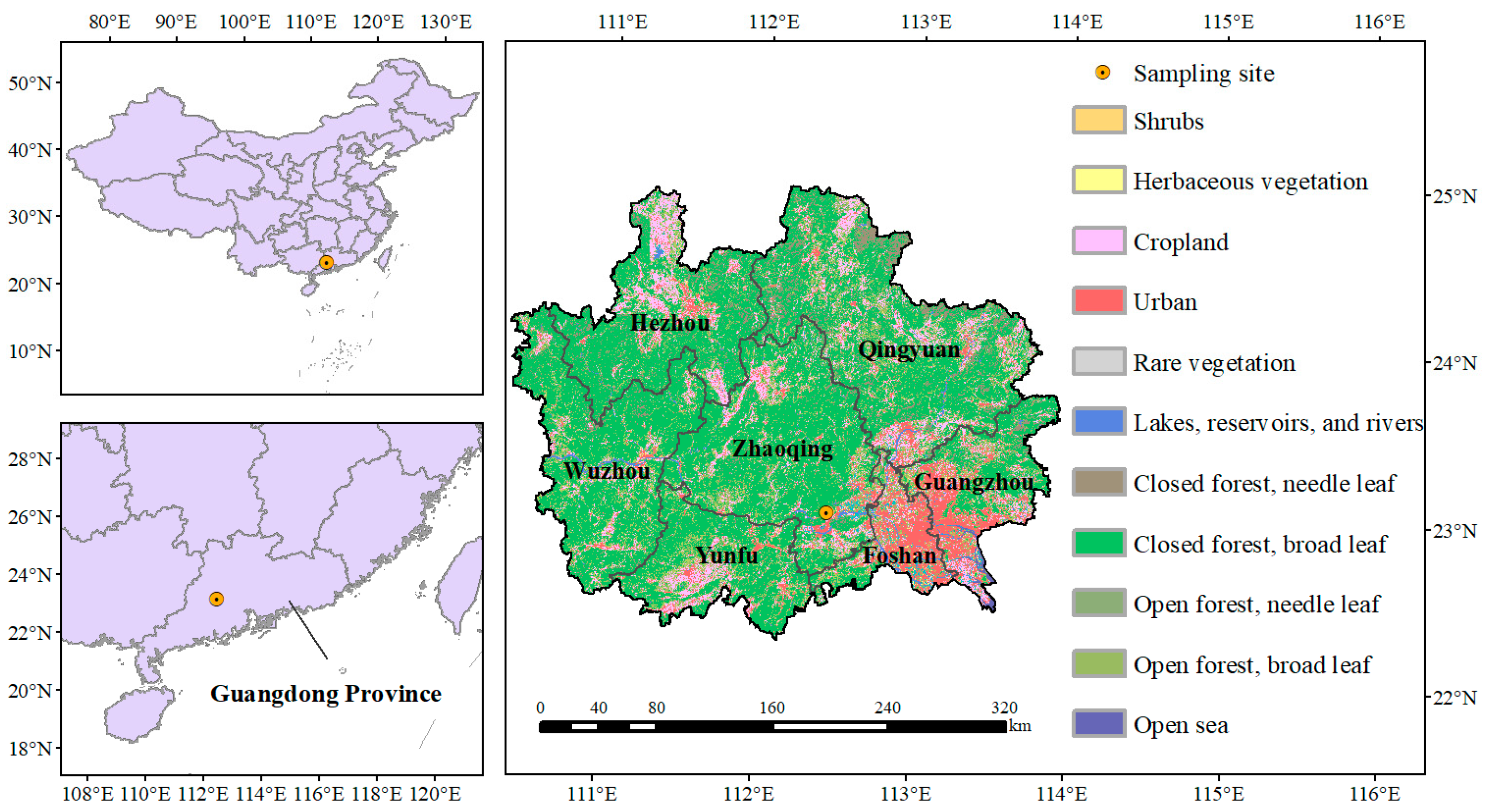
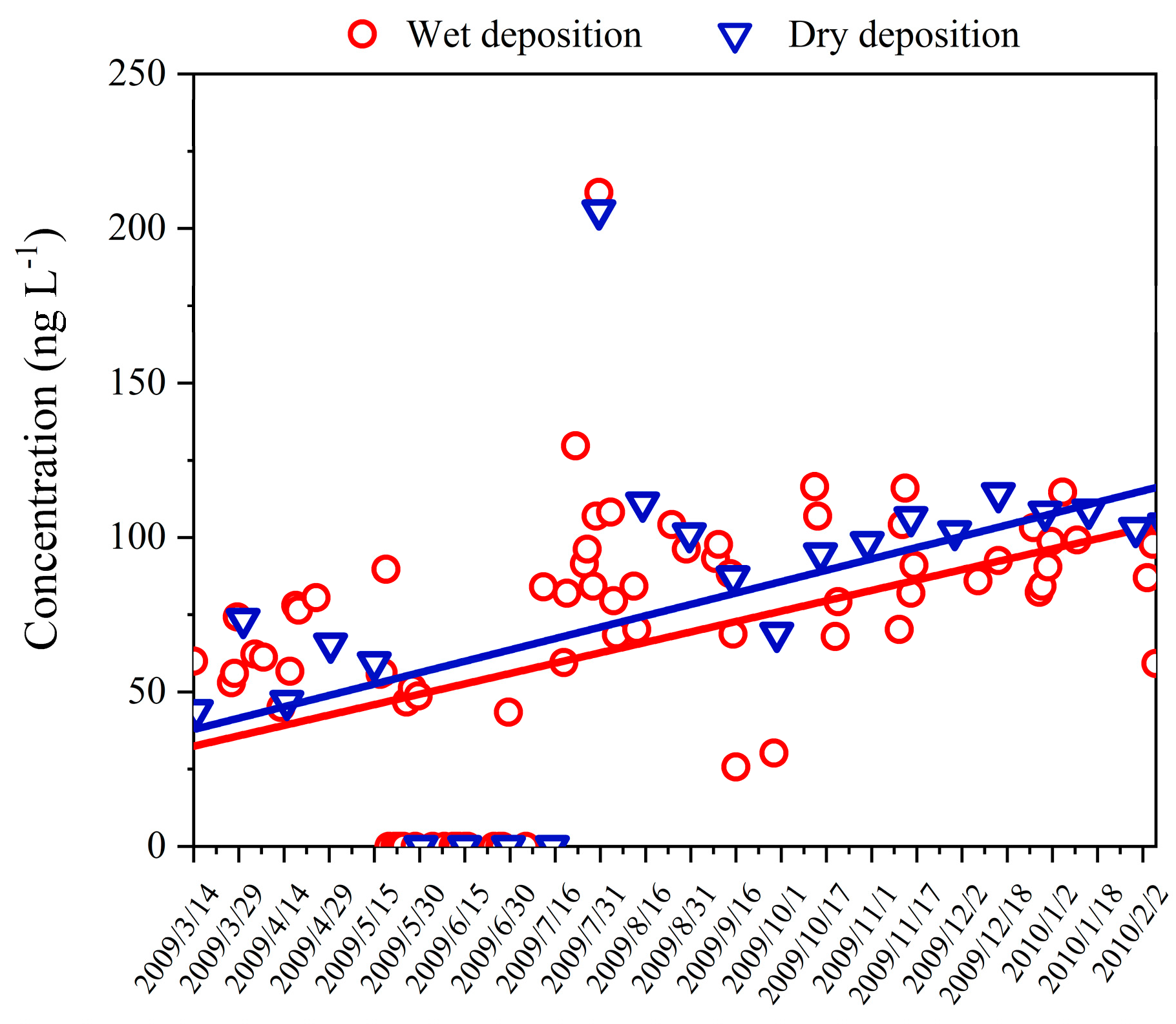
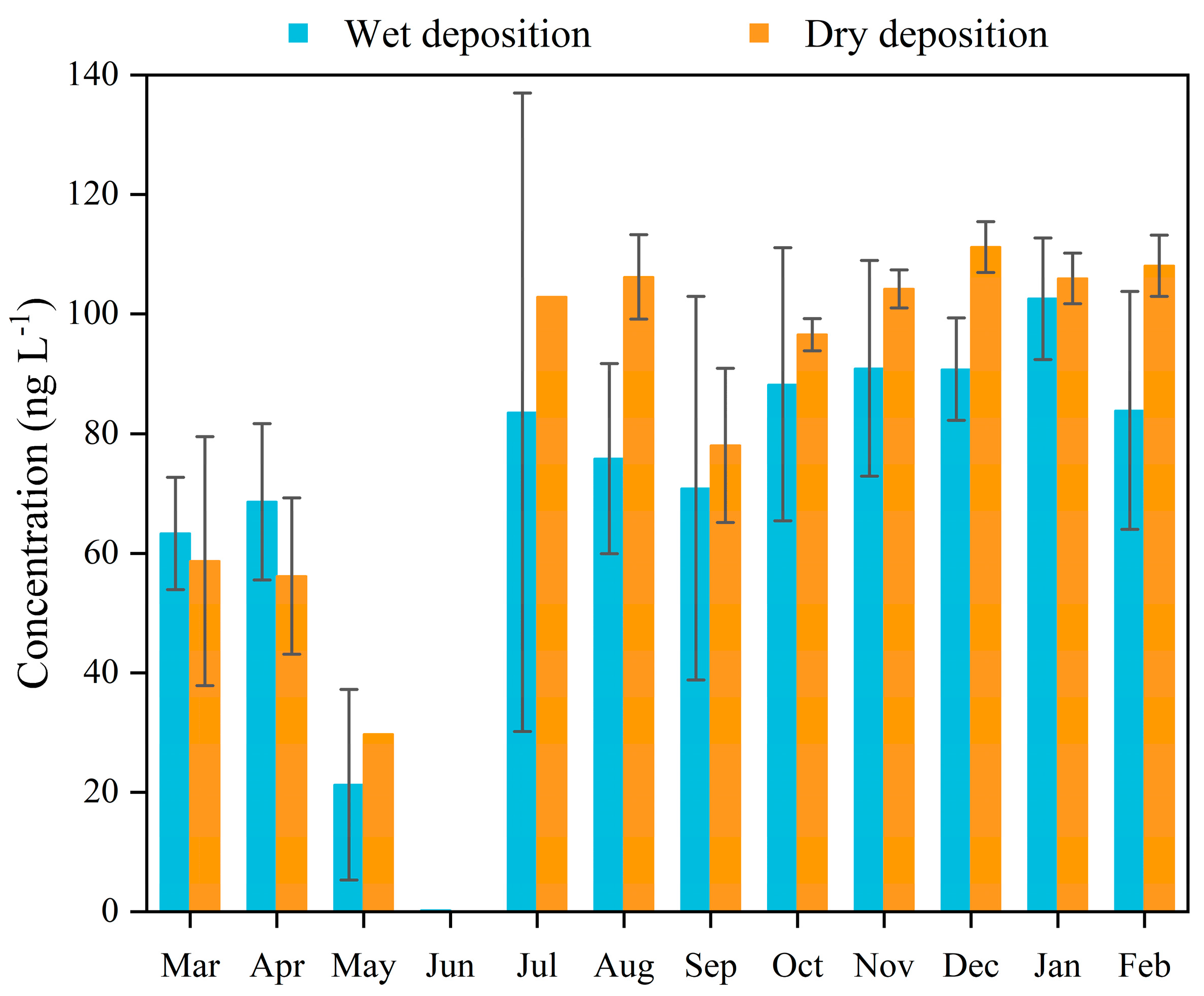
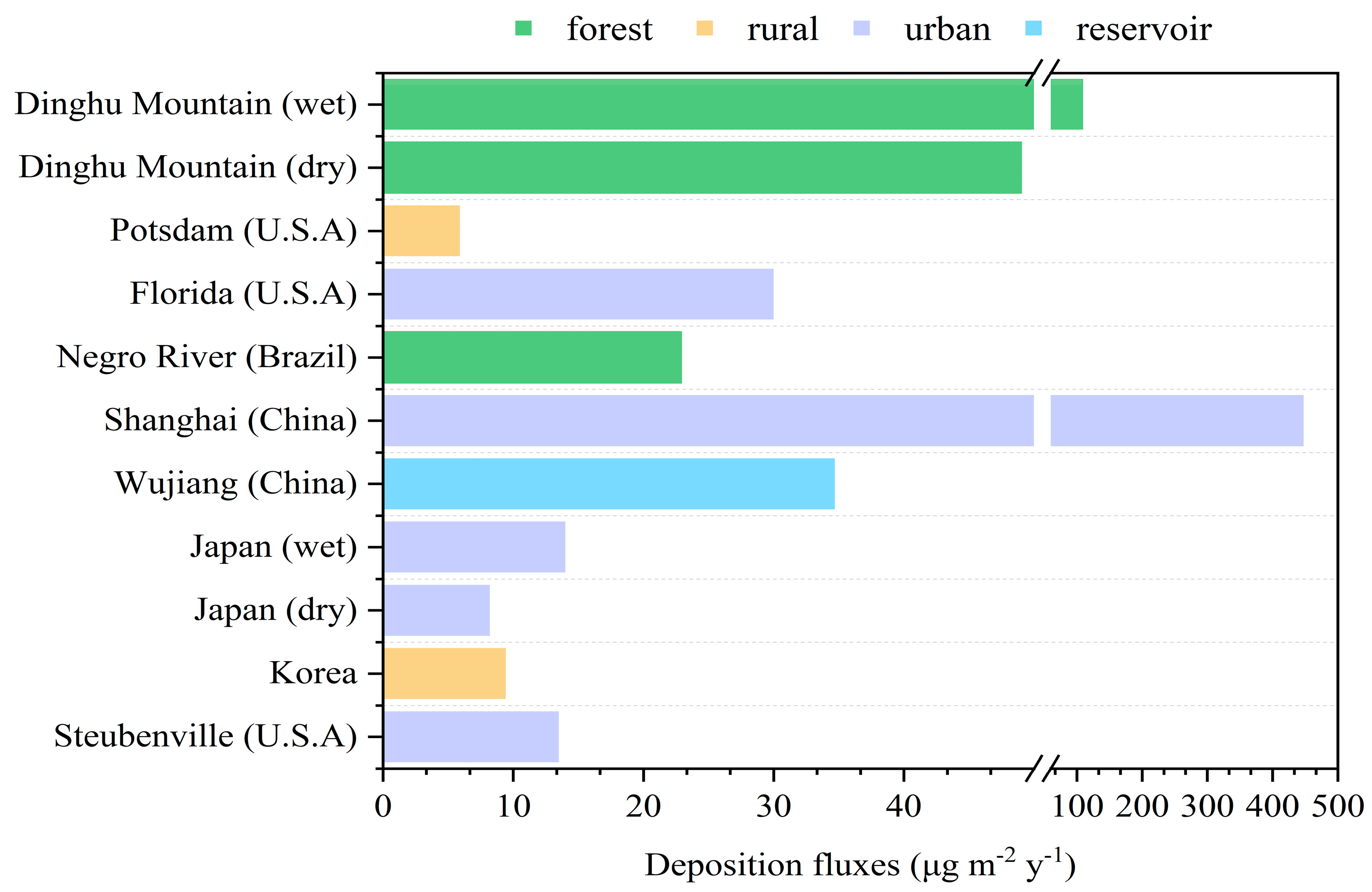
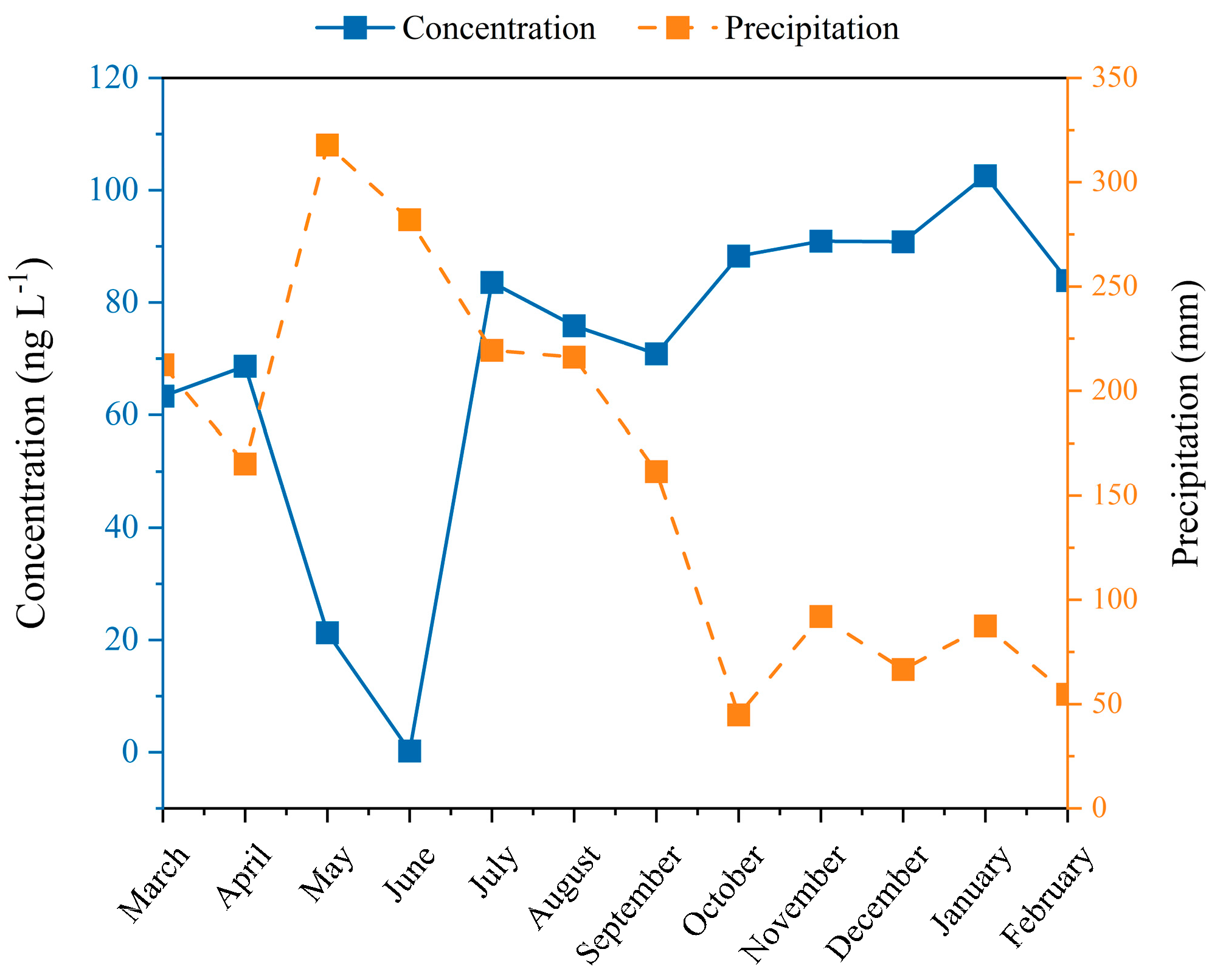

| Region | Surface | Type | Year | Concentration (ng L−1) | Reference |
|---|---|---|---|---|---|
| Beijing | urban | wet | 1995–1996 | 224.0 | [17] |
| Shanghai | urban | wet | 2008 | 220.0 (rural) 300.0 (urban) | [18] |
| Jinyun Mountain | forest | wet | 2013 | 23.40 (Outside) 32.13 (Inside) | [20] |
| Steubenville (USA) | river valley | wet | 2003 | 14.0 | [21] |
| Puerto Rico (USA) | forest | wet | 2005 | 8.9 | [22] |
| Gwangju (Republic of Korea) | suburban | wet | 2016–2019 | 4.1 | [23] |
| Puerto Ángel (Mexico) | coast | wet | 2003–2005 | 7.9 | [24] |
| Dinghu Mountain | forest | wet | 2009–2010 | 56.8 | This study |
| Dinghu Mountain | forest | dry | 2009–2010 | 79.8 | This study |
| Month | Dry | Wet | Total | Dry/Wet |
|---|---|---|---|---|
| March | 2.97 | 13.46 | 16.43 | 0.22 |
| April | 2.44 | 11.34 | 13.78 | 0.22 |
| May | 1.35 | 6.76 | 8.11 | 0.20 |
| June | 0.02 | 0.06 | 0.06 | 0.25 |
| July | 5.41 | 18.34 | 23.75 | 0.30 |
| August | 4.73 | 16.40 | 21.13 | 0.29 |
| September | 3.78 | 11.44 | 15.22 | 0.33 |
| October | 4.38 | 3.96 | 8.34 | 1.11 |
| November | 5.56 | 8.37 | 13.93 | 0.66 |
| December | 6.00 | 6.05 | 12.05 | 0.99 |
| January | 5.50 | 8.98 | 14.48 | 0.61 |
| February | 6.84 | 4.59 | 11.43 | 1.49 |
| Whole year | 49.00 | 109.80 | 158.80 | 0.45 |
| Small Rain | Moderate Rain | Heavy Rain | Above-Heavy Rain | |
|---|---|---|---|---|
| Concentrations (μg·L−1) | 0.064 | 0.073 | 0.040 | 0.058 |
| Wet deposition fluxes (μg·m−2) | 0.285 | 1.160 | 1.606 | 4.226 |
| Hg | Mg | Ca | Cd | Cu | Zn | Pb | Cr | Component | ||
|---|---|---|---|---|---|---|---|---|---|---|
| 1 | 2 | |||||||||
| Hg | 1.000 | 0.185 | 0.177 | 0.064 | 0.310 | 0.307 | 0.222 | 0.308 | 0.278 | 0.488 |
| Mg | 0.185 | 1.000 | 0.253 | 0.258 | 0.428 | 0.628 | 0.304 | 0.450 | 0.510 | 0.579 |
| Ca | 0.177 | 0.253 | 1.000 | −0.005 | 0.054 | 0.128 | −0.034 | −0.015 | −0.260 | 0.846 |
| Cd | 0.064 | 0.258 | −0.005 | 1.000 | 0.237 | 0.242 | 0.278 | 0.076 | 0.437 | −0.021 |
| Cu | 0.310 | 0.428 | 0.054 | 0.237 | 1.000 | 0.498 | 0.556 | 0.547 | 0.764 | 0.231 |
| Zn | 0.307 | 0.628 | 0.128 | 0.242 | 0.498 | 1.000 | 0.377 | 0.572 | 0.654 | 0.477 |
| Pb | 0.222 | 0.304 | −0.034 | 0.278 | 0.556 | 0.377 | 1.000 | 0.523 | 0.787 | 0.000 |
| Cr | 0.308 | 0.450 | −0.015 | 0.076 | 0.547 | 0.572 | 0.523 | 1.000 | 0.755 | 0.230 |
| Hg | Mg | Ca | Cd | Cu | Zn | Pb | Cr | Component | |||
|---|---|---|---|---|---|---|---|---|---|---|---|
| 1 | 2 | 3 | |||||||||
| Hg | 1.000 | 0.041 | −0.040 | 0.078 | −0.034 | 0.127 | −0.038 | 0.126 | −0.123 | −0.104 | 0.793 |
| Mg | 0.041 | 1.000 | 0.310 | 0.170 | 0.102 | 0.216 | 0.253 | 0.482 | 0.299 | 0.531 | 0.422 |
| Ca | −0.040 | 0.310 | 1.000 | −0.403 | −0.010 | 0.678 | −0.084 | 0.252 | −0.172 | 0.921 | −0.111 |
| Cd | 0.078 | 0.170 | −0.403 | 1.000 | 0.470 | −0.002 | 0.602 | 0.106 | 0.767 | −0.235 | 0.244 |
| Cu | −0.034 | 0.102 | −0.010 | 0.470 | 1.000 | −0.013 | 0.720 | 0.064 | 0.842 | 0.056 | −0.156 |
| Zn | 0.127 | 0.216 | 0.678 | −0.002 | −0.013 | 1.000 | −0.047 | 0.172 | −0.058 | 0.778 | 0.063 |
| Pb | −0.038 | 0.253 | −0.084 | 0.602 | 0.720 | −0.047 | 1.000 | 0.220 | 0.916 | 0.042 | 0.025 |
| Cr | 0.126 | 0.482 | 0.252 | 0.106 | 0.064 | 0.172 | 0.220 | 1.000 | 0.217 | 0.445 | 0.568 |
Disclaimer/Publisher’s Note: The statements, opinions and data contained in all publications are solely those of the individual author(s) and contributor(s) and not of MDPI and/or the editor(s). MDPI and/or the editor(s) disclaim responsibility for any injury to people or property resulting from any ideas, methods, instructions or products referred to in the content. |
© 2023 by the authors. Licensee MDPI, Basel, Switzerland. This article is an open access article distributed under the terms and conditions of the Creative Commons Attribution (CC BY) license (https://creativecommons.org/licenses/by/4.0/).
Share and Cite
Dong, H.; Kang, X.; Deng, S.; Huang, M.; Chang, M.; Wang, X. Dry and Wet Deposition Fluxes and Source of Atmospheric Mercury in the Forest in Southeast China. Sustainability 2023, 15, 3213. https://doi.org/10.3390/su15043213
Dong H, Kang X, Deng S, Huang M, Chang M, Wang X. Dry and Wet Deposition Fluxes and Source of Atmospheric Mercury in the Forest in Southeast China. Sustainability. 2023; 15(4):3213. https://doi.org/10.3390/su15043213
Chicago/Turabian StyleDong, Hanying, Xinyuan Kang, Sixin Deng, Minjuan Huang, Ming Chang, and Xuemei Wang. 2023. "Dry and Wet Deposition Fluxes and Source of Atmospheric Mercury in the Forest in Southeast China" Sustainability 15, no. 4: 3213. https://doi.org/10.3390/su15043213






